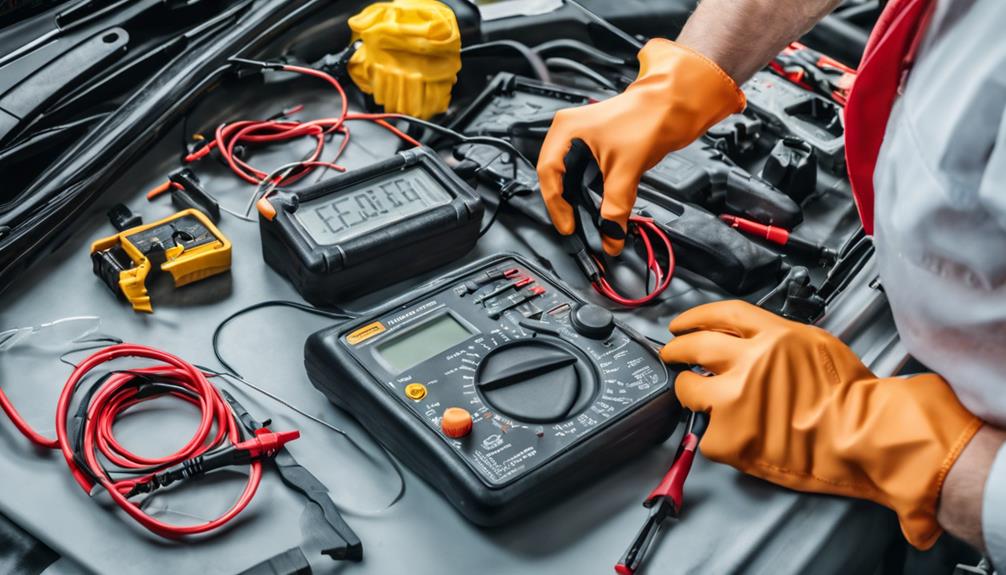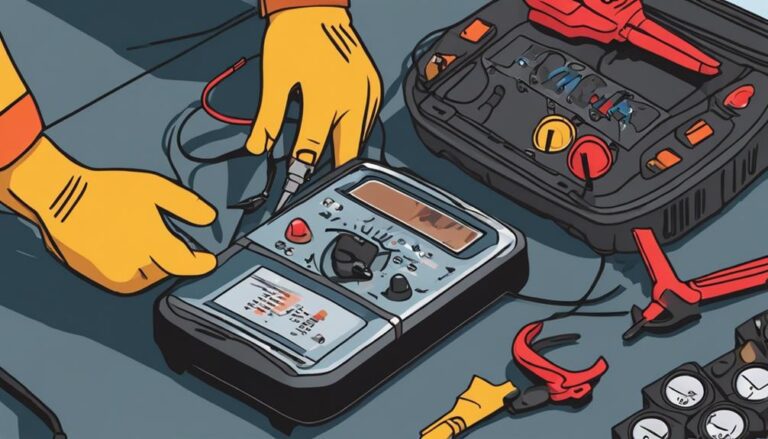7 Best Tips for DIY Car Battery Testing
When it comes to ensuring your car runs smoothly, testing the battery is key. You might think it's a hassle, but taking a few minutes to follow these seven best tips can save you from unexpected breakdowns and costly repairs.
From testing after a period of rest to checking the alternator while the engine is running, each step plays a crucial role in determining your battery's health.
Stay tuned to discover the essential insights to keep your car battery in top shape.
Key Takeaways
- Use a multimeter to test voltage accurately.
- Check for corrosion and physical damage on terminals.
- Verify alternator's proper charging function.
- Monitor battery age for timely replacement.
Multimeter Basics for Battery Testing
To effectively test your car battery using a multimeter, ensure that you set the multimeter to the DC voltage range. Multimeters are indispensable tools for battery maintenance, providing vital insights into the health of your vehicle's power source.
By employing proper multimeter techniques, you can accurately assess if your car battery is holding a charge within the optimal parameters. To begin, connect the multimeter's probes to the battery terminals, observing the polarity to avoid inaccurate readings. Voltage readings obtained through this process will give you a clear indication of the battery's current state.
Regular use of multimeters for battery testing is recommended to catch any potential issues early on and ensure your vehicle's electrical system functions smoothly. Incorporating multimeter practices into your routine maintenance checks will empower you to proactively address any battery-related concerns, promoting a reliable and efficient driving experience.
Safety Precautions Before Testing
Before testing your car battery, ensure you wear gloves and goggles for protection against acid exposure.
Park the vehicle in a well-ventilated area, and always disconnect the negative terminal first to prevent electrical accidents.
Remember to use insulated tools and have a fire extinguisher nearby for added safety while handling the battery.
Safety Gear Required
Ensure you equip yourself with the necessary safety gear before testing a car battery to protect against potential hazards.
Wear safety goggles to shield your eyes from battery acid splashes, and gloves to prevent skin contact with corrosive materials.
Work in a well-ventilated area to minimize exposure to harmful battery fumes.
Avoid loose clothing that could get entangled in moving engine parts near the battery.
Additionally, have a fire extinguisher nearby as a precaution in case of accidental battery-related fires.
Testing Environment Preparation
Properly ventilate the testing area to minimize exposure to battery fumes while preparing for battery testing. Ensure that there is adequate airflow to prevent the accumulation of potentially harmful gases. Additionally, verify that the testing space meets the lighting requirements for safe and efficient testing procedures. Adequate lighting is crucial for accurately inspecting and handling battery components. Below is a table summarizing key safety precautions to consider before proceeding with car battery testing:
| Safety Precautions | Description |
|---|---|
| Proper Ventilation | Ensure adequate airflow to reduce exposure to battery fumes. |
| Lighting Requirements | Verify that the testing area is well-lit for clear visibility during testing. |
| Fire Extinguisher | Have a fire extinguisher nearby as a precautionary measure. |
Steps for Testing Battery Voltage
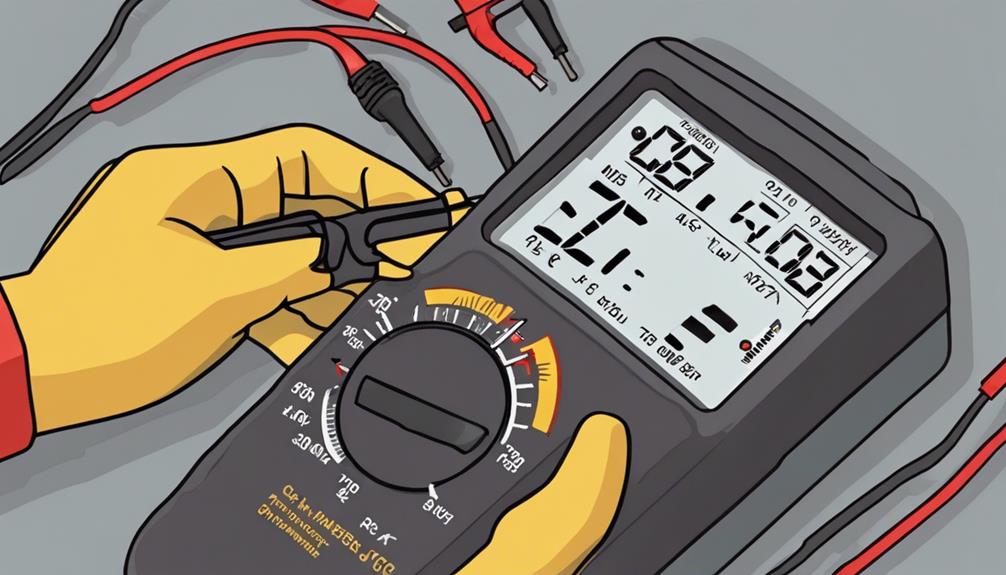
To accurately test the voltage of a car battery, set your multimeter to DC voltage mode and select the 20V setting for precise results.
Begin by connecting the red probe to the positive terminal and the black probe to the negative terminal of the battery. This ensures proper polarity and accurate readings.
A healthy car battery typically registers around 12.6 volts when tested with a multimeter. It's advisable to test the battery after it has been idle for at least an hour to obtain a true resting voltage reading.
Monitoring voltage fluctuations is essential as variations may indicate potential issues with the battery's health. When the vehicle is running, verify that the battery voltage remains above 10 volts to confirm the charging system's functionality.
Following these steps will assist in proper battery maintenance and help identify any underlying concerns promptly.
Interpreting Multimeter Readings Correctly
When using a multimeter for testing car batteries, understanding voltage measurement basics is key.
Additionally, interpreting resistance readings accurately is crucial for diagnosing battery issues.
Familiarize yourself with these concepts to ensure precise assessment of your car battery's health.
Voltage Measurement Basics
For accurate assessment of a car battery's health, mastering the skill of interpreting multimeter readings correctly is essential. When measuring voltage, a fully charged car battery typically shows around 12.6 volts. Readings below this indicate a discharged or weak battery, suggesting low battery capacity.
Watch out for voltage fluctuations and consistent drops during testing, as these may signal a faulty battery. While the vehicle is running, the voltage should remain above 10 volts to ensure proper charging.
Understanding these voltage measurement basics is crucial for determining the status of your car battery accurately. Remember, precise interpretation of multimeter readings is key to maintaining a healthy electrical system in your vehicle.
Understanding Resistance Readings
Understanding resistance readings on a multimeter is crucial for accurately diagnosing potential electrical issues in car batteries and systems. Resistance analysis provides valuable insights into the conductivity of the circuit being tested.
Lower resistance values indicate good conductivity with minimal obstruction to current flow, while higher resistance values suggest poor conductivity or underlying circuit problems. Conductivity evaluation through resistance readings is instrumental in identifying faulty components during car battery testing.
Identifying Signs of a Weak Battery
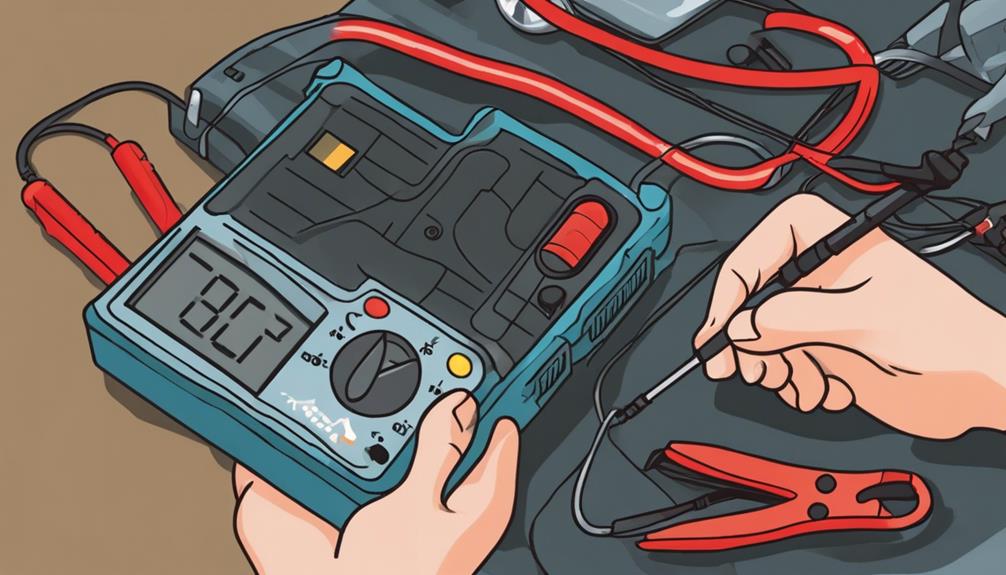
If you notice an illuminated battery light on your dashboard, it could be an indicator of a weak battery. Slow engine cranking during startup, frequent jump starts, clicking noises when turning the engine, and dim lights in the vehicle are all signs that your battery might be losing strength. By paying attention to these symptoms, you can proactively address any potential battery issues before they leave you stranded. To help you further understand the signs of a weak battery, refer to the table below:
| Signs of a Weak Battery | Description |
|---|---|
| Illuminated Battery Light | Indicates a potential issue with the battery |
| Slow Engine Cranking | Difficulty starting the engine may signal a problem |
| Frequent Jump Starts | Repeated need for jump starts can point to a weak battery |
| Clicking Noises | Audible clicking when turning the engine suggests battery trouble |
| Dim Lights | Lights appearing dim may indicate a weakening battery |
How to Test Battery Health Regularly
To accurately assess the health of your car battery, utilize a multimeter to measure its voltage levels regularly. Maintaining your battery is crucial to ensure optimal performance and prevent unexpected breakdowns. Here are some key indicators to watch for when testing your battery health:
- Look for a resting voltage around 12.6 volts for a healthy battery.
- Monitor voltage drop during engine start-up to assess battery health.
- Set your multimeter to 15-20 volts to determine battery charge levels accurately.
- Verify that the voltage remains above 10 volts when the car is running.
Regularly testing your battery's health can help you catch any potential issues early on and avoid being stranded due to a dead battery. Battery maintenance is essential for the overall longevity of your vehicle's electrical system. By monitoring these key indicators, you can ensure that your battery is in good condition and functioning optimally.
When to Consider Battery Replacement
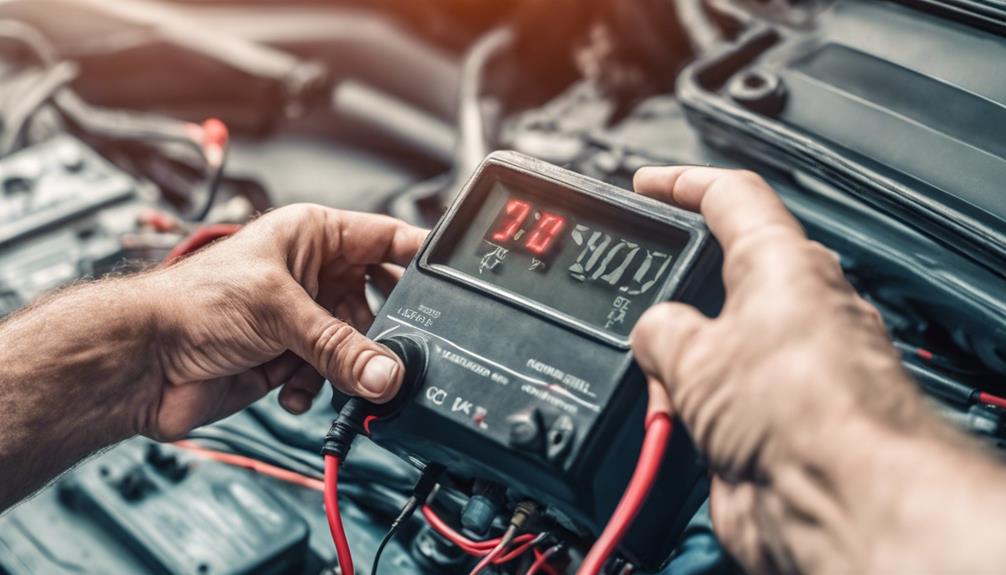
Consider replacing your car battery if it fails a load test, indicating low capacity. It's crucial to be aware of the signs that suggest it's time for a battery replacement to avoid unexpected breakdowns. Below is a table summarizing key battery replacement indicators and when to seek professional guidance:
| Battery Replacement Indicators | When to Seek Professional Advice |
|---|---|
| Fails load test, low capacity | – Unsure of battery condition |
| Struggles to start engine | – Signs of battery failure |
| Over 4-5 years old | – Battery age concerns |
If your battery exhibits any of these signs, it's wise to consider a replacement to ensure your vehicle's reliability. Seeking professional advice when uncertain about the battery's health can prevent inconvenient situations on the road. Remember, timely battery replacement can save you from the hassle of unexpected failures.
Frequently Asked Questions
What Is the Most Accurate Way to Test a Car Battery?
To test a car battery accurately, set your multimeter to measure DC voltage. Connect it to the battery terminals for precise voltage readings. This method provides a clear picture of the battery's state and health.
How Do You Check a Car Battery by Yourself?
To check a car battery yourself, use a multimeter set to measure DC voltage. Connect red probe to the positive terminal, black probe to negative. A healthy battery reads around 12.6 volts. Ensure accurate readings by waiting an hour after the car's been idle.
How Do You Test a Battery to See if It's Good or Bad?
Verify battery vitality via voltage reading. Acquire an accurate assessment with a multimeter. For a thorough evaluation, conduct load testing. Voltage below 12.6V signals a depleted battery, prompting either a recharge or replacement.
What Is the Easiest Way to Check for a Dead Car Battery?
To check for a dead car battery quickly, start with a visual inspection for corrosion. Then, conduct a quick voltage test using a multimeter. A reading below 12.6V indicates a discharged battery, possibly causing starting problems.
Conclusion
In conclusion, testing your car battery is essential for maintaining optimal vehicle performance.
By following the 7 best tips outlined in this article, you can accurately assess the health of your battery and prevent potential issues.
Remember, a healthy battery is the heart of your car, so make sure to test it regularly and take necessary steps for maintenance.
Keep your car running smoothly like a well-oiled machine.

